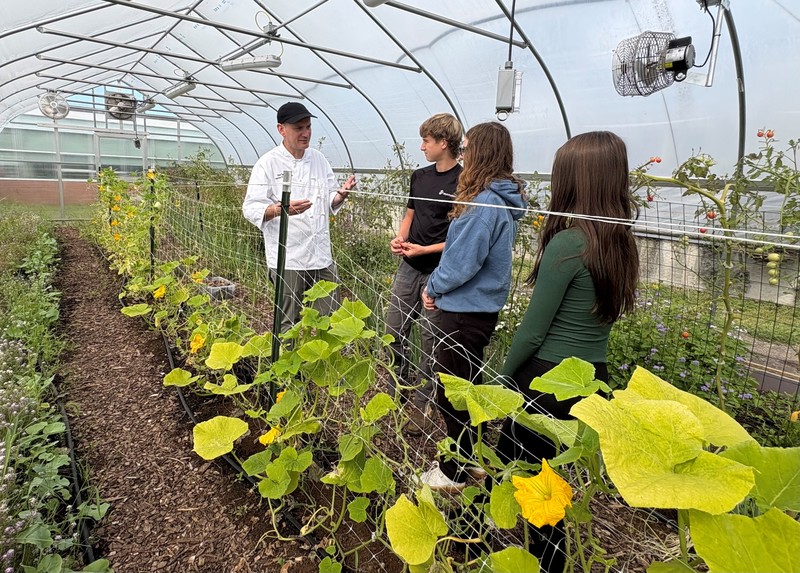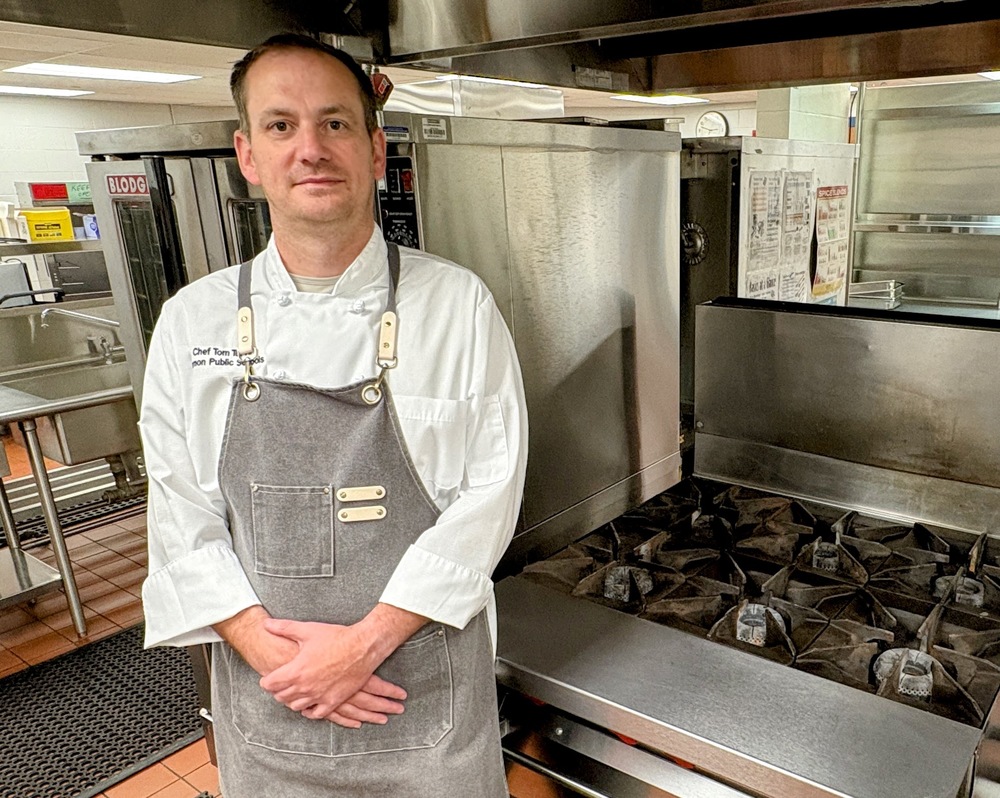The Vernon Public Schools have long focused on providing students with healthy and nutritious meals. A registered dietitian oversees school nutrition and two years ago a farm-to-school coordinator joined the district to further enhance student meals, take farm fresh foods directly to students and strengthen relationships with area farmers.
Chef Tom Turvil joined the food and nutrition team in late spring and spent the summer developing a multi-faceted program to further enhance the meals Vernon students are served. Students will see a lot of Chef Tom in their schools during the coming weeks. And school menus already indicate which meals are “Chef Tom inspired.”
Turvil’s charge is to further incorporate locally produced fruits and vegetables into school meals, have more scratch-cooked offerings and train cafeteria staff in a variety of skills and techniques to enhance school meals. The goal is to provide Vernon students with an even better lunch and breakfast experience and to realize the full benefit and potential of the district’s farm-to-school program.
 Chef Tom with students in the ASTE greenhouse.
Chef Tom with students in the ASTE greenhouse.
“School nutrition is a crucial part of our overall commitment to getting the best out of our students every day,” Vernon Superintendent of Schools Dr. Joseph P. Macary said. “There are direct links between nutrition, a better learning environment and better student outcomes. With Chef Tom, we want to take our food and nutrition program to the next level so that we can help our students continue to achieve at the highest level possible.”
Many Vernon students are eligible for free and reduced school meals. That means the breakfasts and lunches they are served at school play a central role in their daily food intake and overall nutrition. And that’s one of the reasons school leaders and the food and nutrition department sought a grant to fund the chef position.
“Students need food in their bellies if they are going to learn,” said Elizabeth Fisher, the district’s director of food and nutrition. “We want to make sure our kids are ready to learn and that they succeed in school so that they can become productive members of society.”
Kaylee Carlisle, the district’s first farm-to-school coordinator who is now assistant director of food and nutrition, said introducing new foods to students expands their palates and food knowledge. Some students had never experienced the farm fresh produce she has brought into the schools.
Turvil said he wants to expand on the work Carlisle has done and introduce even more fresh fruits and vegetables to Vernon students. He also wants to expand the relationship with the Rockville High School Agricultural Science and Technology Education program, which has grown produce for the school cafeteria.
“We can’t grow enough green peppers to meet our needs in the kitchen, but we can grow specialized foods and bring them in for the kids to experience,” Turvil said, adding he has worked with ASTE staff to develop a growing plan in order to offer a greater variety of vegetables to students.
Turvil is also working on new dishes to add to the cafeteria menus. Continued training of kitchen staff, especially in cooking techniques and knife handling, and regular meetings with kitchen managers will be ongoing.
Turvil, who is English, began cooking at a young age with his mom, attended culinary school and then was admitted to an apprenticeship program. He worked in a variety of restaurants, including some high end establishments, before taking a year off to travel the world. When he went back to work, he took a different route and took a job with an ACS International School near London. That’s where he met his wife, an American.
“I wanted to look for other ways to explore the culinary world that wasn’t the high end that only the top few percent of people could afford,” Turvil said. “I wanted to use my expertise to help more people.”
Turvil has been in the U.S. about 15 years and is married with four children. He worked in a variety of places, but was looking to get back into a school. The Vernon Public Schools chef position “was everything I wanted,” he said. He was especially drawn to Vernon’s farm-to-school program.
“It’s amazing to connect with students and young people and help them make healthier choices,” he said. “I love doing that with kids. The more kids I can impact, the better. I am also really excited about sharing the skills I have learned over the years with our culinary teams at each school to help them grow as cooks and implement long term improvements with more scratch cooking across our menus. It’s important that we are all part of this journey together.”
As enthusiastic as he is about introducing new items to the menu, Turvil appreciates that it has to be a gradual process.
“You can offer many things, but you need to make it approachable for each student,” he said. “Bringing a restaurant dish into the cafeteria might not be successful. We have to offer something the kids recognize, that maybe mom or dad or their grandparents cook for them.”
One way to reach kids may be to help them appreciate the difference between locally sources foods and items shipped hundreds or thousands of miles on trucks.
“A lot of kids know what a tomato looks like, but how many have had a tomato grown within five miles of where they go to school,” he asked. A local tomato is very likely more juicy and flavorful, he said.
During the summer nutrition program at Vernon’s summer camps, Turvil conducted a tomato taste test with campers. “Some of the older kids were shocked,” he said. “If you go to a farm stand or farmers market near your house, you’re probably going to get a really good tomato. As simple as that seems, some of our kids have not experienced that.”
The “grow plan” the food and nutrition department has developed with vocational agriculture teacher Erika Bahler and her plant science students will bring even more fresh, student-grown produce into the cafeteria for students to experience year-round.
Fall crops students will grow include zucchini squash, beets, kale, spaghetti squash, beans, fennel, butternut squash, cabbage, carrots, rutabaga and herbs. Spring crops will include lettuce, kale, celeriac, snap peas, radish and herbs.
Kids will see some change in their cafeteria meals, but it won’t be radical. Turvil said he needs to get to know students and let students get to know him. And he appreciates that there are likely things on the menu he would like to change, but that students love.
“The last thing I want is for a student to leave from their lunchtime not having eaten something,” he said. “We want the students to eat.”
Carlisle said the key is remembering that it is the students who matter.
"We want to offer menu items that students really enjoy,” she said. "Tom will work closely with both students and staff to ensure that. Our goal is to provide flavorful, nutritious meals while highlighting local products through our farm-to-school program.”

